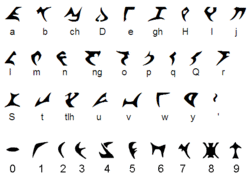Constructed script
A constructed script is a new writing system specifically created by an individual or group, rather than having evolved as part of a language or culture like a natural script. Some are designed for use with constructed languages, although several of them are used in linguistic experimentation or for other more practical ends in existing languages. Prominent examples of constructed scripts include Korean Hangul and the International Phonetic Alphabet.
Constructed scripts and traditional "natural" writing systems
All scripts, including traditional scripts ranging from Chinese to Arabic script, are human creations. However, scripts usually evolve out of other scripts rather than being designed by an individual. In most cases, alphabets are adopted, i.e. a language is written in another language's script at first, and gradually develops peculiarities specific to its new environment over the centuries (such as the letters w and j added to the Latin alphabet over time, not being formally considered full members of the English (as opposed to Latin) alphabet until the mid-1800s). In the vast majority of cases, inventors of writing systems have been either literate themselves or familiar with the concept of writing (see History of writing). As such, constructed scripts tend to be informed by at least one older writing system, making it difficult in some cases to decide whether a new script is simply an adoption or a new creation (for example the Cyrillic[1] and the Gothic alphabets, which are heavily influenced by the Greek alphabet but were nevertheless designed by individual authors).
In the rare cases where a script evolved not out of a previous script, but out of proto-writing (the only known cases being the Cuneiform script, Egyptian hieroglyphs, the Chinese script and the Mayan script, with ongoing debate as to whether the hitherto-undeciphered Indus script and Rongorongo are true writing or proto-writing), the process was nevertheless a gradual evolution of a system of symbols, not a creation by design.[2]
Overview of constructed writing systems
For previously unwritten languages
Some scripts were invented to for spoken languages that did not have adequate writing systems, including Hangul, Cherokee, Syllabics, N'Ko, Fraser, Tangut and Pollard scripts. Armenian, Georgian, and Glagolitic may fit in this category, though their origin is not known.
For religious and mystical purposes
Many scripts are created for religious or mystical purposes. Missionaries and religious scholars may be motivated to devise new scripts for previously-unwritten languages to facilitate the translation of religious writings, as was the case for several of the scripts mentioned in the previous section. Religious leaders may promulgate new writing systems among their followers for liturgical use and/or the promotion of cultural identity and unity, as with Sorang Sompeng,[3] Medefaidrin[4] and the script invented by the Zomi religious leader Pau Cin Hau,[5] among many others. Relatedly, some scripts are created for mystical or magical uses, such as communication with purported spiritual entities. Such is the case with John Dee and Edward Kelley's Enochian language and alphabet, the various scripts (including Celestial, Malachim, Theban, and Transitus Fluvii) documented by Heinrich Cornelius Agrippa and his teacher Johannes Trithemius, and possibly the litterae ignotae devised by Hildegard of Bingen to write her Lingua Ignota.
Several of these scripts are described by their creators as having been revealed during or developed in response to visionary experiences.[3][4][6]
For fictional languages

The best-known constructed scripts dedicated to fictional languages are J. R. R. Tolkien's elaborate Tengwar and Cirth, but many others exist, such as the pIqaD script for Star Trek's Klingon language,[7] Aurebesh from Star Wars,[8] D'ni from the Myst series of video games,[9] and the script of the Orokin language (referred to by members of the community as "Tennobet", a portmanteau of "Tenno" and "alphabet") from the video game Warframe.
For technical purposes
Several writing systems have been devised for technical purposes by specialists in various fields. One of the most prominent of these is the International Phonetic Alphabet (IPA), used by linguists to describe the sounds of human language in exhaustive detail. While based on the Latin alphabet, IPA also contains invented letters, Greek letters, and numerous diacritics. Other scripts, such as John Malone's Unifon,[10] Sir James Pitman's Initial Teaching Alphabet,[11] and Alexander Melville Bell's Visible Speech[12] were invented for pedagogical purposes. Yerkish, a communication system created for use by non-human primates, involves a system of lexigrams- visual symbols corresponding to various objects and ideas.[13] Shorthand systems may be considered constructed scripts intended to facilitate speed and ease of writing.
Language reform
Some constructed scripts are intended to replace existing writing systems. In the mid-1800s, the Church of Jesus Christ of Latter-day Saints promoted the Deseret alphabet as an alternative writing system better suited to English phonology;[14]:65–66 roughly a century later, the estate of Irish playwright George Bernard Shaw commissioned the Shavian alphabet (later developed into Quikscript) to serve similar aims.[15][16]:9–11 Graphic Designer Bradbury Thompson's Alphabet 26 represents a similar project. (see also: English-language spelling reform). Taking language reform further, various proposed philosophical or auxiliary languages- such as aUI, Solresol, and the language outlined in John Wilkins' 1668 An Essay Towards a Real Character, and a Philosophical Language have associated writing systems. Charles K. Bliss's Blissymbols represent a proposed international auxiliary language whose primary mode is written rather than spoken.[17]:89–90
Other
Several constructed scripts serve unique purposes not outlined above. Ong Kommandam's Khom Script, in addition to serving a religious role, was used to conceal military communications during the Holy Man's Rebellion.[18] Around the turn of the 18th century, Frenchman George Psalmanazar invented a purported 'Formosan' alphabet to further his fraudulent claims of being the first Taiwanese visitor to Europe; the Coelbren y Beirdd alphabet invented by Iolo Morganwg is another such example of linguistic forgery.[19] Braille[20]:161–162 and most other tactile alphabets were invented to serve the needs of the visually impaired, or, in the case of Lewis Carroll's Nyctography, of sighted people without access to light.[21]
Encoding
Some neographies have been encoded in Unicode, in particular the Shavian alphabet and the Deseret alphabet. A proposal for Klingon pIqaD was turned down because most users of the Klingon language wrote it using the Latin alphabet, but both Tengwar and Cirth were under consideration in 2010. An unofficial project exists to coordinate the encoding of many constructed scripts in specific places in the Unicode Private Use Areas (U+E000 to U+F8FF and U+000F0000 to U+0010FFFF), known as the ConScript Unicode Registry.
Some of the scripts have identifying codes assigned among the ISO 15924 codes and IETF language tags.
See also
- List of constructed scripts
- Asemic writing
- Voynich Manuscript
- Fictional alphabet
- Conlang
References
- ↑ Lunt, Horace Gray (2001). Old Church Slavonic Grammar. Berlin: Mouton de Gruyter. ISBN 3-11-016284-9.
- ↑ Trigger, Bruce G. (January 1998). "Writing systems: A case study in cultural evolution". Norwegian Archaeological Review 31 (1): 39–62. doi:10.1080/00293652.1998.9965618. ISSN 0029-3652. http://www.tandfonline.com/doi/abs/10.1080/00293652.1998.9965618.
- ↑ 3.0 3.1 Everson, Michael (2009-06-08). "Proposal for encoding the Sora Sompeng script in the UCS". Working Group Document. International Organization for Standardization. http://std.dkuug.dk/jtc1/sc2/wg2/docs/n3647.pdf.
- ↑ 4.0 4.1 Rovenchak, Andrij; Gibbon, Dafydd; Ekpenyong, Moses; Urua, Eno-Abasi (2016-04-18). "L2/16-101R: Proposal for encoding the Medefaidrin (Oberi Okaime) script in the SMP of the UCS". ISO/IEC JTC1/SC2/WG2. https://www.unicode.org/L2/L2016/16101r-medefaidrin.pdf.
- ↑ Pandey, Anshuman (2011-04-27). "N4017: Proposal to Encode the Pau Cin Hau Alphabet in ISO/IEC 10646". Working Group Document, ISO/IEC JTC1/SC2/WG2. https://www.unicode.org/L2/L2011/11104r-paucinhau-alphabet.pdf.
- ↑ Leitch, Aaron (2010a). The Angelical Language, Volume I: The Complete History and Mythos of the Tongue of Angels. Woodbury, MN: Llewellyn Publications. ISBN 978-0738714905.
- ↑ "Writing Klingon – Klingon Language Institute". http://www.kli.org/about-klingon/writing-klingon.
- ↑ McKalin, Vamien (November 27, 2015). "Google Translate's 'Star Wars' Easter Egg Adds Support For Aurebesh". Tech Times. http://www.techtimes.com/articles/111268/20151127/google-translate-s-star-wars-easter-egg-adds-support-aurebesh.htm.
- ↑ Pearce, Celia (2006). "Productive Play: Game Culture From the Bottom Up". Games and Culture 1 (17): 17. doi:10.1177/1555412005281418.
- ↑ Everson, Michael. "Preliminary proposal to encode "Unifon" characters in the UCS". http://std.dkuug.dk/JTC1/SC2/WG2/docs/n4195.pdf.
- ↑ "What is ITA?". ITA Foundation. http://itafoundation.org/about-us/what-is-i-t-a/.
- ↑ Winzer, Margret A (1993). The History Of Special Education: From Isolation To Integration. Washington, DC: Gallaudet University Press. ISBN 978-1-56368-018-2.
- ↑ "Interactive Lexigram, History of Ape Language". 2010. http://www.greatapetrust.org/science/history-of-ape-language/interactive-lexigram/.
- ↑ Moore, Richard G. (2006). "The Deseret Alphabet Experiment". Brigham Young University. http://web.chem.ucla.edu/~jericks/Historical%20or%20Technical/History%20Looking%20Backwards/Magazine%20articles/The%20Religious%20Educator/Deseret%20Alphabet%20Experiment2.pdf.
- ↑ Weintraub, Stanley. "Shaw, George Bernard". Oxford Dictionary of National Biography (online ed.). Oxford University Press. doi:10.1093/ref:odnb/36047. ISBN 978-0-19-861412-8. https://www.oxforddnb.com/view/10.1093/ref:odnb/9780198614128.001.0001/odnb-9780198614128-e-36047. Retrieved 17 July 2022. (Subscription or UK public library membership required.)
- ↑ Shaw, Bernard (1962). The Shaw Alphabet Edition of Androcles and the Lion. Harmondsworth, Middlesex, England: Penguin Books Ltd.. pp. 9–11. https://archive.org/details/AndroclesAndTheLion_ShawAlphabetEdition.
- ↑ Bliss, C. K. (1965). [Semantography (Blissymbolics). 2d enlarged edition. A simple system of 100 logical pictorial symbols, which can be operated and read like 1+2=3 in all languages (...)] "Semantography - A Logical Writing for an illogical World, by CK BLISS". http://www.symbols.net/semantography/.. Sydney: Semantography (Blissymbolics) Publications. OCoLC: 1014476.
- ↑ Sidwell, Paul. 2008. The Khom script of the Kommodam Rebellion. International Journal of the Sociology of Language 192.
- ↑ "Coelbren y Beirdd - The Bardic Alphabet". Amgueddfa Cymru — National Museum Wales. http://www.museumwales.ac.uk/en/888/.
- ↑ Olstrom, Clifford E. (2012-07-10). Undaunted By Blindness. Watertown, MA: Perkins School for the Blind. ISBN 978-0-9822721-9-0. https://books.google.com/books?id=k9K77s1IRgoC. Retrieved 4 December 2011.
- ↑ “The Life And Letters Of Lewis Carroll (Rev. C. L. Dodgson)” by Stuart Dodgson Collingwood B.A. Christ Church, Oxford
External links


